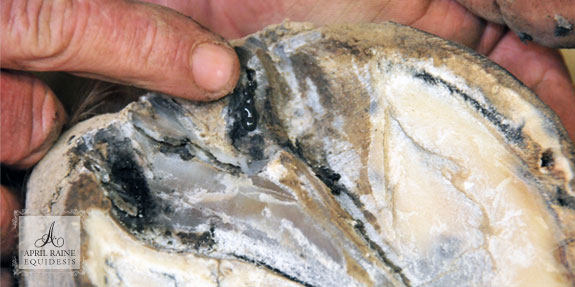KNOW YOUR SOURCES
I‘ll keep writing and adding materials to this section, so check back often, and don't hesitate to drop me a note if you're interested in a particular topic. If you find any of these pieces worth printing and sharing, please be kind enough to leave my name attached.
If you have questions, please contact me at:
765.491.2414
thrush
For years, it was thought to be a fungal disease, but modern science has cleared that up, and we now know that the thrush we find in horses' hooves is bacterial. In fact, we know that it's an anaerobic bacteria, fusobacterium necrophorum , which is present in all animal feces and most soil samples.
When it sets up residence in the horse's hoof, it generally localizes in the frog and is usually most prevalent in the collateral sulci (or commissures) and/or in the central sulcus. As an anaerobic bacteria, it thrives in a moist, dark, poorly oxygenated environment. Once it's established, you can recognize its presence from many symptoms typically associated with thrush infections... | read more |
to shoe or not to shoe
Whether you're cruising horse sites on the internet or flipping through the equine section at the supermarket newsstand, you'll likely encounter some strongly held opinions. Currently, many of the opinions being forwarded are focused on hoof care; specifically, they're focused on a debate about whether it's better for your horse to be barefoot or to wear shoes.
It's the nature of debate that the middle ground is often ignored, and this debate stays the course, with each side tending to forward their belief as THE way rather than as A way. Interestingly enough, the people at the extremes in this debate are—for the most part—not farriers and hoof care professionals. Instead, they're primarily horse owners... | read more |
SmartPak Ask the Farrier: Hoof Circulation Q & A
with Danvers Child, CJF
When studying equine anatomy, it’s often useful to draw comparisons to human anatomy. It’s easier to understand hoof dynamics when we compare the hoof’s structure and composition to the nails on our own fingers and toes... | read more |
SmartPak Ask the Farrier: Q & A with Danvers Child, CJF
As a farrier, I’d love to claim that it’s all about me, but the truth is that healthy hooves result from overall good horsemanship and attendance to a complex web of concerns, including hoof care, nutrition, age, climate, environment, activity, and genetics. Since elements like age and genetics are beyond our control, we have to focus our caretaking on the areas we can realistically influence. The topics you mention—hoof care and supplementation—are our best opportunities to make a positive impact on hoof growth... | read more |








